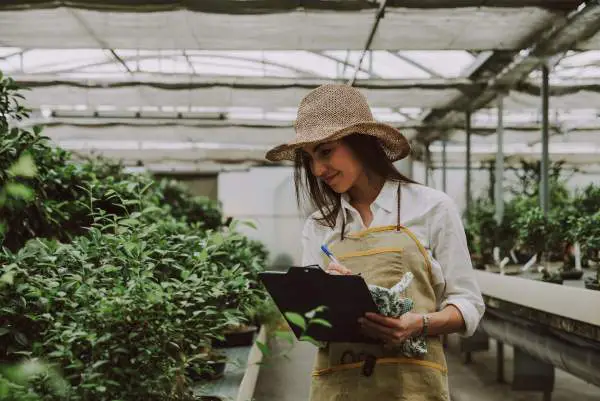As an alternative method to cultivating and growing plants, hydroponics is an industry that is blossoming into the mainstream gardening niche.
As interest in hydroponics increases, so do the questions regarding its sustainability and effects on the environment.
Is Hydroponics Farming Sustainable?
Yes, hydroponics is in fact good for the environment because it offers a higher-yield alternative to soil food production, saves water, and limits the usage of pesticides and herbicides.
What Is Hydroponics?
Before delving into the many benefits of hydroponics, let’s explore what exactly hydroponics is first. The simplest explanation is hydroponics is gardening without soil. Plants are grown in a controlled environment such as sand, gravel, or liquid with nutrient-rich solutions as ‘food.’
While the popularity of hydroponics is growing rapidly, it is not a new concept, by any means. The floating gardens of the Aztecs and the hanging garden of Babylon are two examples of ancient hydroponics.
Hydroponic gardens are maintained through a special system – either purchased or built by hand – that allows the roots of the plant to come in direct contact with the nutrients and oxygen that it needs to grow.
5 Reasons Why Hydroponics is Better than Soil Farming
1. Higher Yield
There are two reasons for the higher production in hydroponics compared to traditional farming. Both come down to space. Outdoor gardens require a lot of it, whereas hydroponic gardens can fit into the smallest of apartments, which makes them perfect for urban areas.
Furthermore, the roots of the plants have access to all the nutrients they need in the reservoir tank. The roots won’t need to expand or stretch out in search of food, meaning you can grow plants much closer, resulting in a year-round growth and higher yield per limited space.
2. Uses Less Water
With a worldwide water crisis on the horizon, saving water is at the forefront of every grower’s agenda. Hydroponics is the perfect solution for reducing wasteful water consumption. The plants are hydrated by a nutrient-rich water solution that can be reused for weeks at a time.
3. Less Land Erosion
Common estimates say that the earth is 71% water. That leaves 29% of the earth’s surface as land, over half of which isn’t habitable, let alone sustainable for farming and gardens. When land is used for gardening, the soil must constantly be tilled, and eventually, that spot of land becomes useless.
Some consider hydroponics to be the farming of the future, as the idea of inhabiting other planets grows. There isn’t any viable soil in space.
4. Reduced Use of Pesticides
While hydroponics isn’t completely insect-free, there are significantly fewer pests involved in soil-less farming, as most pests tend to need the soil to survive. Pesticides are not only harmful to the environment, but they can also be harmful to people – either through air exposure or ingestion.
Given the way plants are grown in hydroponics, weeds don’t have a chance to grow. This reduces the need for any herbicides, which are used to kill weeds. It also removes any physical labor in pulling out weeds.
5. Works in Any Climate
Depending on where you live, the ground could be frozen for half the year, making outdoor gardening a six-month Spring/Summer activity.
Hydroponics allows you to grow plants regardless of how wet or dry your climate is. This aspect is becoming increasingly important as climate change issues are becoming more widespread.
Common Hydroponic Systems
There are 6 main types of hydroponic systems – wick, continuous drip, Ebb and Flow, deep water culture, nutrient film technique, and aeroponics. All the systems involve a reservoir of nutrient-rich solution underneath a tray or basket where the plants are growing and each uses a different technique to feed the solution to the roots.
- Wick
The wick system is the most rudimentary system. It uses a wick — a rope or piece of felt, for example – to draw the solution toward the roots. The solution is then absorbed by the roots directly.
- Continuous Drip
The most widely used system, the drip system uses a timer that is connected to a pump that drips the nutrient solution onto the plants at a pre-set time. The drip method ensures that the plants aren’t drowned in the solution.
- Ebb and Flow
The ebb and flow system has a pump as well, but the pump temporarily floods the grow tray with the required nutrients and then catches the run-off back in the reservoir, which is then recirculated at the next feeding.
- Deep Water Culture
In a DWC system, the most low-maintenance of the systems, the plants are housed in styrofoam containers on a platform above the solution. The platform is continuously immersed in the solution. This system works best with small plants that grow quickly, such as leaf lettuce.
- Nutrient Film Technique
NFT for short, the nutrient film technique is a little different from the others. The plants are held in net pots high above the reservoir in a channel and the solution flows directly over the roots via a pump. The solution then drains back into the reservoir for reuse.
- Aeroponics
Like NFT, the plants in the aeroponics system are held above the solution in baskets. A timed pump lightly mists the roots on a schedule. The pre-set feature is what makes the aeroponic system the most technologically advanced.
Aquaponics
It would be remiss not to mention the practice of aquaponics – the combining of hydroponics with aqua farming. This technique uses snails and other fish to fertilize the solution that is then used to feed the plants.
The symbiotic relationship between the animals and plants allows for efficient, environmental-friendly gardening where the animals purify the water and their waste provides food for the plants.
Which Plants Work Best with Hydroponics?
You might be surprised to know that you can grow more than just vegetables in your hydroponic garden. The plants that work best in hydroponic systems are the ones that are durable and fast-growing.
When you first begin indoor gardening, it is best to start with the easiest plants to prevent becoming frustrated and giving up your dreams of having an indoor garden altogether.
The three types of plants mostly found in hydroponics gardens are:
- Vegetables
The best types of vegetables that grow in hydroponic gardens are leafy greens (spinach, lettuce) and vine plants (tomatoes, technically a fruit.) While it is possible to grow root vegetables such as potatoes in hydroponic systems, it takes extra care and experience.
Vegetables grown hydroponically tend to grow bigger than those of the soil-based method because the plant has to exert less energy in reaching out to its nutrients. The nutrients are fed directly to the roots, giving it more energy to grow quickly and at a larger pace.
- Herbs
Who doesn’t like to use herbs to add flavor to their homemade dishes? Hydroponics is a great method of growing thyme, basil, and oregano, to name just a few. The herbs can be pruned as needed to encourage growth, but it’s not necessary.
One benefit of growing herbs in your indoor garden is you will be assured that they are truly organic and pest-free.
- Houseplants
Yes, even some houseplants can be grown using hydroponic systems! The best way to grow houseplants indoors is by using the hydroponic system that entails hanging the plant and misting, which ensures the roots won’t be oversaturated.
The best houseplant for hydroponic gardening is the spider plant. The advantages to hydroponic-grown houseplants are reduced allergens in the air and mold prevention.
While herbs, vegetables, and houseplants can all be grown hydroponically, they should all be in their own separate systems. Herbs typically can be grown together, but mint does best in its own system, as the roots need more room to grow than other herbs.
What About Fruit Trees?
While vegetables and vine fruits such as tomatoes are the most common plants grown in a hydroponic system, it is possible to grow fruit trees such as bananas and apples indoors.
It will take some finagling, patience, and a lot of expertise, but with the right equipment (heat lamps and seeds) and extra room to grow, you can have yourself an indoor fruit tree.
Frequently Asked Questions
What Are the Disadvantages to Hydroponic Gardening?
There is something to consider before beginning your hydroponic garden. And that is how reliable is your power source? Hydroponic gardens can fall victim to a power outage that could potentially kill all of the plants. Many of the systems rely on pumps, which need electricity to run.
So, if there is one advantage soil-based gardening has over hydroponics is that you don’t have to worry about power outages, but you do have to worry about mother nature.
Is Hydroponics Better Than Soil?
The answer to this question comes down to preference and the reasons you are considering hydroponics. If your climate is the main reason for your desire to garden indoors, then yes, it is better than soil because, with hydroponics, you don’t have to consider frozen ground/soil.
Plants that are grown using hydroponics instead of soil-based grow quicker because the nutrients are delivered directly to the roots.
Are Hydroponic Plants Healthy?
The healthiness of hydroponic plants depends on what solution is being used to grow the plants. Soil is naturally rich in the nutrients necessary for plants to grow.
The solution used in hydroponics is created to replicate that nutrition, but if you don’t use the correct ingredients, your plants won’t be healthy enough to prosper.





